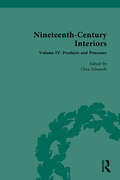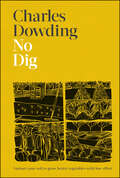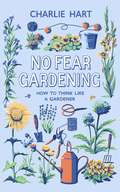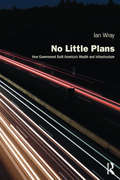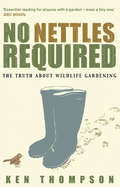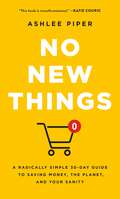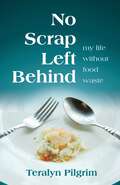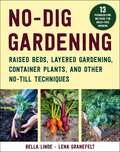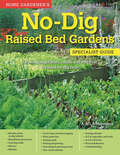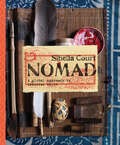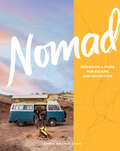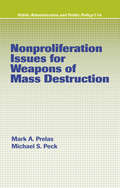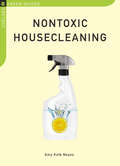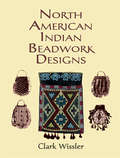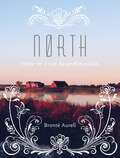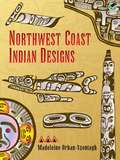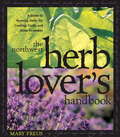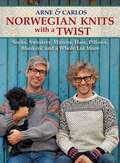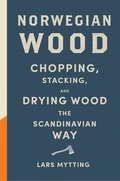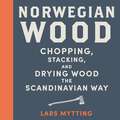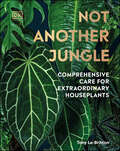- Table View
- List View
Nineteenth-Century Interiors: Volume IV: Products and Processes
by Clive EdwardsThis volume of primary source materials documents the essential practical aspects of making a home, decorating it and then furnishing it. The crucial constitutive parts that make up an interior from floor to ceiling are considered here in detail. The role of advice books and articles that attempted to direct homemakers in particular directions are examined, as are the more practical how-to publications that demonstrated the processes of interior decoration. Accompanied by extensive editorial commentary, this collection will be of great interest to students and scholars of art history.
No Dig: Nurture Your Soil EBK 22
by Charles DowdingWork in partnership with nature to nurture your soil for healthy plants and bumper crops - without back-breaking effort!Have you ever wondered how to transform a weedy plot into a thriving vegetable garden? Well now you can! By following the simple steps set out in No Dig, in just a few short hours you can revolutionize your vegetable patch with plants already in the ground from day one!Charles Dowding is on a mission to teach that there is no need to dig over the soil, but by minimizing intervention you are actively boosting soil productivity. In fact, The less you dig, the more you preserve soil structure and nurture the fungal mycelium vital to the health of all plants.This is the essence of the No Dig system that Charles Dowding has perfected over a lifetime growing vegetables.So put your gardening gloves on and get ready to discover: - Guides and calendars of when to sow, grow, and harvest.- Inspiring information and first-hand guidance from the author- &“Delve deeper&” features look in-depth at the No Dig system and the facts and research that back it up.- The essential role of compost and how to make your own at home.- The importance of soil management, soil ecology, and soil health.Now one of the hottest topics in environmental science, this "wood-wide web" has informed Charles's practice for decades, and he's proven it isn't just trees that benefit - every gardener can harness the power of the wood-wide web. Featuring newly- commissioned step-by-step photography of all stages of growing vegetables and herbs, and all elements of No Dig growing, shot at Charles&’s beautiful market garden in Somerset, you too will be able to grow more veg with less time and effort, and in harmony with nature - so join the No Dig revolution today!A must-have volume for followers of Charles Dowding who fervently believe in his approach to low input, high yield gardening, as well as gardeners who want to garden more lightly on the earth, with environmentally friendly techniques like organic and No Dig.
No Fear Gardening: How To Think Like a Gardener
by Charlie HartDesperate to use this time to get out into your garden but don't know where to start? This is the book you need!'An easy read with no gardening know-how required . . . Hart's enthusiasm flows from the page . . . Up-to-date thinking on wildlife, wellbeing and no-dig cultivation pop up too, which are applicable to gardens big and small, making this a perfect introduction to gardening without the fear of doing something wrong' Gardens IllustratedAre you frightened of your garden? Terrified of accidentally bringing death to a sap-filled friend? Put off by the overwhelming number of species of plants and their baffling Latin names? Whether your garden is a sprawling country plot or a kitchen windowsill, gardening is good for the mind, body and soul. Yet just the thought of picking up a pair of secateurs can strike fear into even the bravest of hearts, meaning we often don't make the most of our personal Edens.Charlie's 'no fear' approach to gardening will help you find the easy path to beautiful borders and jampacked vegetable beds. A reassuring, simple-to-use handbook, No Fear Gardening is aimed at all budding gardeners and anyone who might be missing out simply because they don't know how and where to start. Whatever the reason, this book will answer all your questions. From digestible lists of what seeds to plant where, guides to pruning and how to cope with difficult spots to Charlie's favourite vegetables to grow (and, more importantly, eat) and essential pieces of kit, Charlie has condensed a wealth of gardening know-how into easy-to-follow and practical tips. With its unique, liberating approach, No Fear Gardening will inspire you to dust the cobwebs off your watering can and get your garden blooming, whatever the weather or season.
No Fear Gardening: How To Think Like a Gardener
by Charlie HartDesperate to use this time to get out into your garden but don't know where to start? This is the book you need!'An easy read with no gardening know-how required . . . Hart's enthusiasm flows from the page . . . Up-to-date thinking on wildlife, wellbeing and no-dig cultivation pop up too, which are applicable to gardens big and small, making this a perfect introduction to gardening without the fear of doing something wrong' Gardens IllustratedAre you frightened of your garden? Terrified of accidentally bringing death to a sap-filled friend? Put off by the overwhelming number of species of plants and their baffling Latin names? Whether your garden is a sprawling country plot or a kitchen windowsill, gardening is good for the mind, body and soul. Yet just the thought of picking up a pair of secateurs can strike fear into even the bravest of hearts, meaning we often don't make the most of our personal Edens.Charlie's 'no fear' approach to gardening will help you find the easy path to beautiful borders and jampacked vegetable beds. A reassuring, simple-to-use handbook, No Fear Gardening is aimed at all budding gardeners and anyone who might be missing out simply because they don't know how and where to start. Whatever the reason, this book will answer all your questions. From digestible lists of what seeds to plant where, guides to pruning and how to cope with difficult spots to Charlie's favourite vegetables to grow (and, more importantly, eat) and essential pieces of kit, Charlie has condensed a wealth of gardening know-how into easy-to-follow and practical tips. With its unique, liberating approach, No Fear Gardening will inspire you to dust the cobwebs off your watering can and get your garden blooming, whatever the weather or season.
No Little Plans: How Government Built America’s Wealth and Infrastructure (Planning, History and Environment Series)
by Ian WrayIs planning for America anathema to the pursuit of life, liberty and happiness? Is it true, as ideologues like Friedrich Von Hayek, Milton Friedman, and Ayn Rand have claimed, that planning leads to dictatorship, that the state is wholly destructive, and that prosperity is owed entirely to the workings of a free market? To answer these questions Ian Wray’s book goes in search of an America shaped by government, plans and bureaucrats, not by businesses, bankers and shareholders. He demonstrates that government plans did not damage American wealth. On the contrary, they built it, and in the most profound ways. In three parts, the book is an intellectual roller coaster. Part I takes the reader downhill, examining the rise and fall of rational planning, and looks at the converging bands of planning critics, led on the right by the Chicago School of Economics, on the left by the rise of conservation and the ‘counterculture’, and two brilliantly iconoclastic writers – Jane Jacobs and Rachel Carson. In Part II, eight case studies take us from the trans-continental railroads through the national parks, the Federal dams and hydropower schemes, the wartime arsenal of democracy, to the postwar interstate highways, planning for New York, the moon shot and the creation of the internet. These are stories of immense government achievement. Part III looks at what might lie ahead, reflecting on a huge irony: the ideology which underpins the economic and political rise of Asia (by which America now feels so threatened) echoes the pragmatic plans and actions which once secured America’s rise to globalism.
No Nettles Required: The Reassuring Truth About Wildlife Gardening
by Ken ThompsonIn 2003 a MORI poll for the Royal Horticultural Society revealed that an extraordinary number of us are interested in attracting wildlife into our gardens. It also indicated, however, that many of us have no idea how to go about it. Information is sparse, and public opinion seems to suggest that gardens that are plentiful in wildlife are unattractive, expensive to upkeep and hard work to maintain. But this couldn't be further from the truth.In this illuminating book, Ken Thompson explains that encouraging wildlife is actually entirely compatible with ordinary gardening, costs next to nothing and is almost completely effortless. Packed with helpful hints and tips, the book shows us how easy it is to fill our gardens with everything from foxes, frogs and mice to butterflies, ladybirds and literally thousands of fascinating creepy-crawlies. Why should we? Because we'll be promoting the biodiversity of the UK, we'll be reconnecting with nature, getting more from our gardens, and we'll be doing our plants a favour.
No New Things: A Radically Simple 30-Day Guide to Saving Money, the Planet, and Your Sanity
by Ashlee PiperFrom award-winning sustainability expert Ashlee Piper, a witty, no-nonsense guide to regaining control over your time, consumerist impulses, and financial and mental wellnessFor nearly two years, Ashlee Piper challenged herself to buy nothing new. And in the process, she got out of debt, cut clutter, crushed her goals, and became healthier and happier than ever—all the things she’d always wanted to do but “never had time to” (because she was mindlessly scrolling, shopping, spending, and stressing). After a decade of fine-tuning, No New Things guides readers through the same revolutionarily simple challenge that has helped thousands of global participants find freedom and fulfillment in just thirty days.The book follows the rise of what Piper calls “conditioned consumerism” and how it sneakily hijacks our time, money, and mental bandwidth, as well as harms the planet. From there, readers follow customizable daily action items that bring about the ease and richness of a life less bogged down by spending and stuff, without compromising on style, convenience, or fun.Whether you’re a bona fide shopaholic or someone who just wants to buy less and live more, No New Things is the antidote to modern overwhelm.
No Scrap Left Behind: My Life Without Food Waste
by Teralyn PilgrimThe story of a mother&’s quest to end her family&’s food waste—and all the blunders that came with it.Teralyn Pilgrim had no idea the environmental and economic impact of food waste, or that she could save $100 a month by being waste free. But when a story of hungry children fills her with unbearable guilt, she decided to make a change to the way her family approached mealtime. Despite finicky kids and a skeptical husband, Pilgrim turned her feelings of guilt into action and created a zero-food waste kitchen. Pilgrim began her journey by defining food waste with Rule #1: the Hungry Kid Test—would you throw something edible away with a hungry child watching? If the answer is yes, it can go in the compost. If the answer is no, then it&’s time to get creative. Narrating her trials and errors—emphasis on errors—Pilgrim invites readers to her table where leftover food is a personal challenge to reduce waste, save money, and guard against squandering natural resources. Things get tricky when she discovers a five-year-old fish in her freezer, accidentally buys the grossest fat-free cookies in the world, and finds her dog is as picky as the kids. Addressing myths about how being waste-free is too hard (it&’s not) and whether expiration dates mean anything (they don&’t), Pilgrim teaches readers clever ways to be resourceful while also offering a broader look at why food waste matters and the global effects of this massive problem. Both a resource for families and a call for worldwide change, No Scrap Left Behind offers nine-step program and hundreds of food-related tips to help readers find their own way to sustainable living, trim the grocery bill, and effect change...starting in their own kitchens.
No Sew, Low Sew Decorative Storage: 50 Stylish Projects to Stash Your Stuff
by Carol ZentgrafThe saying is true: you can never have too much storage. And now, creating beautiful hatboxes, shoe racks, baskets, and even tuffets and ottomans that can be used for storage, has never been easier. Many of these inexpensive projects can be completed with a hot glue gun, basic hand stitches, and other fast and easy techniques.No Sew, Low Sew Decorative Storage offers 40+ inexpensive and easy-to-make projects of all sizes that can be used throughout the house. Anyone with basic sewing or crafting skills can successfully follow the step-by-step instructions and 200 photos to success in organizing their entire household in beautiful style.
No-Dig Gardening: Raised Beds, Layered Gardens, and Other No-Till Techniques
by Bella LindeDiscover how to create a weed-free, sustainable, abundant garden with the no-till gardening method! The no-dig or no-till gardening method is an easy and climate-smart technique that is gaining in popularity and revolutionizing the gardening world. This book teaches you everything you need to start and care for a kitchen garden without any digging, watering, or weeding. Too good to be true? Find out for yourself! No-dig gardening is better for the environment, easier on your back, and yields abundant vegetables, herbs, and flowers. Learn everything you need to get started! Layer your garden properly (the lasagna method)Choose the right cover materialsWhen to plant seedlings and when to direct sowHow to compostLearn about permaculture techniquesAttract the good insects and repel the unwanted onesRecognize common plant diseases Chock-full of practical tips and designed with gorgeous photos throughout, this is your guide to a healthy, eco-friendly, abundant garden.
No-Dig Raised Bed Gardens: Growing vegetables, salads and soft fruit in raised no-dig beds (Home Gardener's)
by Gill Bridgewater Alan BridgewaterHome Gardener’s No-Dig Raised Bed Gardens is the essential guide to gardening successfully with the minimum amount of digging and weeding. For those without the time or stamina to spend hours maintaining a garden, horticulture experts Alan and Gill Bridgewater show how to make raised beds, build up layers of soil with mushroom compost, cover weeds with mulch, protect plants with nets and plastic, and much more. The text is thoroughly practical and advocates using organic methods where possible. This book is a must for busy gardeners everywhere. It is ideal for first time gardeners who want to learn the basics, and it is perfect for busy and older gardeners looking for simple, no-nonsense gardening methods.
Nobody Wants Your Sh*t: The Art of Decluttering Before You Die
by Messie CondoFree yourself and your family from the f*cking clutter before you croak! Inspired by The Gentle Art of Swedish Death Cleaning, Nobody Wants Your Sh*t will light a fire under your untidy ass with humor and helpful organizing tips that you&’ll actually want to use. Like a delightfully foul-mouthed best friend, this book dishes out the funny, unpretentious advice you need to hear most. You&’ll discover how to deal with your sh*t like there&’s no tomorrow, live in the moment without the f*cking mess, and make your life and your eventual death a hell of a lot easier. With this witty guide, you&’ll learn how to:ditch the d*mn indecisionget your sh*t together and feel fantasticgive your busy family a f*cking breakand more! Whether you&’re getting ready to move in, move on, or just move your ass, Nobody Wants Your Sh*t will help you take control of your f*cking life.
Nomad: A Global Approach to Interior Style
by Sibella Court“A rich-tapestry celebration of [Court’s] meanderings—from Japan to Italy, Syria to Mexico and India . . . Essential for anyone who adores travel.” —Australian Women OnlineIn this deluxe guide, celebrated designer Sibella Court travels the world in search of eclectic inspiration. She explores far-flung destinations and captures the essence of each in small details, exotic color palettes, exquisite textures, and traditional crafts. Along the way, she shows readers how to incorporate these elements into interiors and how to replicate the ideas in their own spaces. Overflowing with imaginative ideas from across the globe with breathtaking photos of each destination accompanied by examples of gorgeous real-life interiors, plus tips for applying the looks at home Nomad promises to serve as the ultimate lookbook for designers and wanderers the world over.“Stylist Sibella Court shows us how to bring our travels home with us in the most unexpected of ways. She has travelled to Syria, Mexico, Italy, India and Japan to be inspired by everything from door knobs and street signs to roadside shrines and household brooms. The ideas, photographs and mementos she collected are used to inspire room settings, illustrating simple, practical and surprising ways to be reminded of your travel experiences.” —The House Directory“Sibella Court shows us how to incorporate the objects you collected during your travels in your interior. Again, this is not a step-by-step book but rather a book to get ideas and make them your own. It also makes you aware of what to bring with you from your journeys be it textiles, traditional crafts or small details that capture the essence of a foreign place.” —30s Magazine
Nomad: Designing a Home for Escape and Adventure
by Emma ReddingtonA reclusive designer living in a custom tiny house in the middle of the Montana wilderness. A couple who traded their expensive Bay Area apartment for a slip at a nearby marina, where they live on a docked sailboat. A family of five who decided to simplify their lives by moving into a school bus, selling most of their possessions in the process. Nomad features their stories, and many more. From vanlifers to boondockers, liveaboards to tiny-house dwellers, these freedom seekers have forged a new way of life for themselves—one that values experiences over things, is environmentally conscious, and is often more budget-friendly than their &“rooted&” lives ever were. The ubiquity of the internet has ushered in a new era of connectivity that makes working from an Airstream beside a roaring river or running a photography business from a mountaintop a reality. It&’s now possible to do whatever you want from wherever you want and still have a foothold in the world. This book shows you how, with tours of 26 unconventional homes and the people who live in them, plus all the information you need to make your own off-the-grid dream a reality. There are chapters on bathroom and storage—two of the most challenging aspects of this lifestyle—plus a comprehensive guide to finding the right home, assessing the cost of renovation, handy products for small spaces, and indispensable resources (including sources for replacement RV parts, portable power solutions, tiny wood stoves, and much more).
Nonproliferation Issues For Weapons of Mass Destruction (Public Administration and Public Policy)
by Mark A. Prelas Michael S. PeckNonproliferation Issues for Weapons of Mass Destruction provides an understanding of WMD proliferation risks by bridging complex technical and political issues. The text begins by defining the world conditions that foster proliferation, followed by an analysis of characteristics of various classes of WMDs, including nuclear, biological, and chemica
Nontoxic Housecleaning
by Amy Kolb NoyesWhen it comes to cleaning products, society often values convenience over personal and planetary health, thanks to decades of advertising propaganda from the chemical companies that market overpriced and dangerous concoctions. But awareness is changing: Not only are homemade and nontoxic cleaners strong enough for the toughest grunge, they are often as convenient as their commercial counterparts.Nontoxic Housecleaning—the latest in the Chelsea Green Guide series—provides a way for people to improve their immediate environment every day. Pregnant women, parents of young children, pet owners, people with health concerns, and those who simply care about a healthy environment—and a sensible budget—can all benefit from the recipes and tips in this guide.Included are tips for:The basic ingredients: what they are, and why they work.Specific techniques for each room and cleaning need in the house.Detailed recipes for homemade cleaners, including floor polishes, all-purpose cleanser, disinfecting cleanser, window cleaner, oven cleaner, furniture polish, mold- and mildew-killing cleansers, bathroom scrub, deodorizers, stain removers, laundry boosters and starch, metal polishes, scouring powder, and more.
North American Indian Beadwork Designs
by Clark WisslerThis concise volume documents a fascinating and unique art form -- Native American beadwork. Including examples of handiwork from Eastern woodlands and Plains Indians, the author offers a clear, illuminating discussion of the origins, execution, and symbolism of Indian beadwork used to ornament belts, garters, pouches, and much more. Over 300 figures.
North American Indian Beadwork Patterns (Dover Crafts: Bead Work)
by Pamela Stanley-MillnerIn these pages you'll find 73 charts for bead weaving and 12 full-page patterns for bead appliqué — all taken from authentic craftwork of the Cheyenne, Sioux, Crow, Sauk & Fox, Winnebago, Kickapoo, Cree, Arapaho, and other Native American groups. Complete instructions are provided along with color keys for every chart and pattern.Use the charts to weave belts, headbands, sashes, necklaces, and other eye-catching accessories. You'll find the appliqué patterns are perfect for decorating leather, denim, and other fabrics. It's a great way to embellish handbags, vests, blouses, and other apparel and personal items. By following the clear step-by-step instructions in this book, even beginners can create a host of attractive beadwork projects with authentic Native American flavor.
North: How to Live Scandinavian (How To Live... Ser.)
by Brontë AurellA complete guide to Scandinavia filled with travel tips, cultural and historical facts, recipes, and inspirational photography from the Nordic nations.Why are Scandinavians constantly topping the happiness table? How do you get more Scandi-style in your life? Just how do you use lagom? Whether you want your apartment to look like it belongs in Copenhagen, to workout like a Norwegian or to make cinnamon buns like a Swede, this is the ultimate insider’s guide to the countries of the north.Full of inspiration and ideas, how-tos and recipes to help you experience the very best of Scandinavian design, philosophy, cookery, and culture, this honest behind-the-scenes look at the culture provides an invaluable insight into the wonderful and visually stunning world of Scandinavia. Like her viking ancestors before her, Brontë Aurell left Denmark to explore the world beyond home shores and in her travels has come to understand the fascination with her kinfolk, as well as seeing the idiosyncrasies of the Scandinavian lifestyle that locals take for granted.With a signature wit and a keen eye for detail, she takes you on a journey through fjords and mountains, farmlands, and cities to better understand these three nations and what makes each one so unique. So get outdoors, learn the life lesson that there’s no such thing as bad weather (only bad clothing), and you may discover your inner Scandi sooner than you think . . . From the How To Live . . . series of insightful guides to some of the most intriguing cultures and locations on the planet, other books available include How To Live Japanese, How To Live Korean, and How to Live Icelandic.
Northwest Coast Indian Designs
by Madeleine Orban-SzontaghIn this volume, noted illustrator Madeleine Orban-Szontagh renders designs produced by the Indians of the Pacific Northwest, Alaska, and the western coast of Canada: Nootka, Kwakiutl, Tlingit, Haida, Tsimshian, and other groups. More than 270 original designs include stylized plants, birds and animals, abstract borders and repeating patterns, totemic images and symbols, and a host of other decorative elements. These arresting and beautiful Native American images lend themselves to use in a wide range of Indian-related graphic art and craft projects, as well as providing a rich source of design inspiration.
Northwest Herb Lover's Handbook
by Mary PreusThe soothing smell of lavender, rosemary's piney flavor, the bright colors of nasturtiums . . . herbs are wonderful things! In this handsome volume, Mary Preus provides a delightful entree into the world of herbs with detailed instructions on how to grow 50 of the most popular herbs and create an herbal lifestyle. Easy and delicious recipes, herbal crafts and gifts, landscaping with herbs, traditional and modern medicinal use, aromatherapy--it's all here in The Northwest Herb Lover's Handbook.
Norwegian Knits with a Twist
by Carlos Zachrison Arne NerjordetTraditional embroidery, tapestry, and knitting motifs from Setesdal, in the south of Norway, are brilliantly reconceived in this fabulously fresh collection of knitting projects from Arne and Carlos. Through experience gained from working alongside Scandinavia&’s most respected knitters, Arne and Carlos seek to preserve tradition—with their own creative &“twist&”! Over 30 patterns promise endless sources of delight and inspiration: men&’s and women&’s sweaters, pillows, hats, cowls, mittens, wrist and leg warmers, socks, blankets, and so much more! Includes gorgeous photographs, step-by-step instructions, and pattern diagrams.
Norwegian Wood: The guide to chopping, stacking and drying wood the Scandinavian way
by Lars MyttingTHE DEFINITIVE WOOD-CUTTER'S BIBLE - THE BESTSELLING, YEAR-ROUND GUIDE TO CHOPPING, STACKING AND DRYING WOOD "The book has spread like wildfire" Daily Mail"A how-to book with poetry at its heart" T.L.S."A step-by-step guide to preparing your wood store" IndependentWhether you're a seasoned woodcutter, or your passion is yet to be kindled, NORWEGIAN WOOD is an entertaining guide for year-round wood management, and the perfect gift.Chopping and stacking wood is a pastime where the world makes sense once more. Because our relationship to fire is so ancient, so universal, it seems that in learning about wood, you can also learn about life.And who better to impart this wisdom than an expert from Scandinavia, where the extreme climate has obliged generations to hone and share their skills with tools, wood and heat production. Lars Mytting has distilled the wisdom of enthusiasts, from experienced lifelong growers, stackers and burners to researchers and professionals of combustion and tree culture.Part guide to the best practice in every aspect of working with this renewable energy source, part meditation on the human instinct for survival, this definitive handbook on the art of chopping, stacking and drying wood in the Scandinavian way has resonated across the world, with more than a million copies sold worldwide.More than 175,000 copies sold in English editions. The book that defined a genre.
Norwegian Wood: The guide to chopping, stacking and drying wood the Scandinavian way
by Lars MyttingTHE DEFINITIVE WOOD-CUTTER'S BIBLE - THE BESTSELLING, YEAR-ROUND GUIDE TO CHOPPING, STACKING AND DRYING WOOD "The book has spread like wildfire" Daily Mail"A how-to book with poetry at its heart" T.L.S."A step-by-step guide to preparing your wood store" IndependentWhether you're a seasoned woodcutter, or your passion is yet to be kindled, NORWEGIAN WOOD is an entertaining guide for year-round wood management, and the perfect gift.Chopping and stacking wood is a pastime where the world makes sense once more. Because our relationship to fire is so ancient, so universal, it seems that in learning about wood, you can also learn about life.And who better to impart this wisdom than an expert from Scandinavia, where the extreme climate has obliged generations to hone and share their skills with tools, wood and heat production. Lars Mytting has distilled the wisdom of enthusiasts, from experienced lifelong growers, stackers and burners to researchers and professionals of combustion and tree culture.Part guide to the best practice in every aspect of working with this renewable energy source, part meditation on the human instinct for survival, this definitive handbook on the art of chopping, stacking and drying wood in the Scandinavian way has resonated across the world, with more than a million copies sold worldwide.More than 175,000 copies sold in English editions. The book that defined a genre.
Not Another Jungle: Comprehensive Care for Extraordinary Houseplants
by Tony Le-BrittonObsessed with houseplants? You&’ve come to the right place. This isn&’t any ordinary houseplant book. In fact, there is nothing ordinary about these extraordinary plants. From growing his own collection, Tony Le-Britton of Not Another Jungle, shows you how to grow and care for the world&’s most sought after plants.Detailed chapters on light, water, humidity, fertilizer, variegation, propagation, and pests and diseases have you covered so you can confidently care for all your houseplants. Understanding their natural habitats empowers you to create the optimum environment in your own home so your plants will thrive. Combining detailed care advice and stunning imagery on a wide range of plants, including Monstera and Anthurium, with a special focus on desirable and unusual varietiesIf you&’re intent on becoming a devoted plant parent this year, dive straight in to discover:- Step-by-step advice on everything you need to know to grow and care for houseplants.- Information on variegated plant varieties for which there is currently huge interest.- Stunning inspirational and step-by-step photography.- Illustrations explain scientific information on plant anatomy. - Explains how to source plants sustainablyAll the plants featured are available internationally and can be acquired by US readers (many plants have their origins in South America or Asia). Wonder at the natural world with Not Another Jungle and curate and care for your own incredible collection of happy, healthy houseplants.
